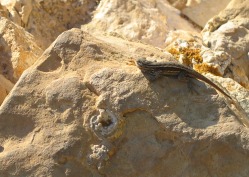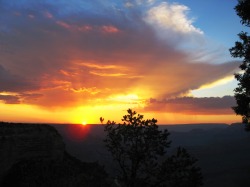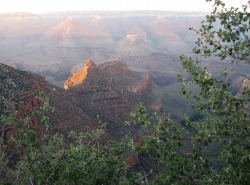|
Yesterday I hiked first to Dripping Springs then to Santa Maria Springs via the Hermit Trail. There had been a good downpour the night before, replete with thunder and lightning. I know this because it woke me from a deep sleep. A monsoon. The day however brought steady fog, and variations between mist and drizzle. A fine distinction perhaps only made by residents of the Pacific Northwest. It’s all rain to Arizonans. The trail bore marks of having posed as a temporary stream, with deep rivets and fissures parting the sediment. There were moments where the path seemed in danger of washing away altogether in areas where slide met sudden exposure. Deer and coyote left printed evidence of their passing in the red slope. The Navajo distinguish between “male rains” and “female rains.” I struggle with these categories. The phrase “hell hath no fury like a woman scorned” comes to mind. Hard and soft. Black and white. Where are the nuanced mists? The stinging pellets of hail in all of this? Biological truths do reveal themselves in these simplified categories. Men do seem to be responsible for a majority of pillage and destructive force. Gandhi was fascinated by the lives of soldiers. Yet, men have slaughtered in the name of Helen, Cleopatra, Isabella, Elizabeth, and the gentle monikers of wives, daughters, mothers, and great-aunts. Are women not capable of rage? Have men never cried? At the same time, the Navajo and Hopi are matrilineal societies; women possess a great deal of power in that regard. At least where traditional values are still regarded. Internal debate within the tribe considers the painful choices of compromise versus economic stability. Mining, water rights, tourism. It was a picture of a woman on the digital page of The Navajo Times newspaper standing alone atop a mesa, stalwart in her convictions about preventing another heli pad for fat white tourists to be built on her homeland. Hers were not the eyes of a fragile mist, I saw monsoons of hardship and endurance. Okay, so you can't really see her eyes in the picture, but her bearing implies it.
For the Navajo, The Rez being labeled “the third world” is an ironic one. In Navajo creation myth the Diné have emerged from three worlds and are currently living in a fourth. The poverty is striking. How could it be anything different to a privileged middle class school librarian? I still live check to check, I’ve been laid off, known the misery of not having my skills valued. I recently took a new job at a lower rate of pay, but it was on my terms, my choice. Or at least I tell myself that, as it may really have been preventative paranoia about being bumped around by public politics. We are taught in white culture to value the number of zeros attached to a paycheck. Each year I grow older I value happiness over the social imperative to “get ahead.” In reading the introduction to a travel guide on the Four Corners, the author relates an encounter where he picked up a hitchhiking Navajo man who told him about his work herding horses, then simply stated, “I am happy.” Returning to the idea of the genders being reduced to rainfall intensity, maybe it is that simple, but it isn’t about genders, it’s about state of mind. Male or female we rage and caress with the same hand. There is a time for righteous anger and a time to console. Then there’s the problem of reducing acts of nature to human situations. Nature simply is. Indifferent to the human condition, that’s its draw, its lure. The imperative is then to know thyself. Know when to rage and when to caress. The words of my favorite song (“Librarian,” from My Morning Jacket) about unrequited love come to mind, “Everything’d be great, everything’d be good, if everybody gave like everybody could.” Give like a monsoon and not a drizzle I might add.
0 Comments
Your comment will be posted after it is approved.
Leave a Reply. |
AuthorJenny Gapp, has twenty years experience as a teacher librarian, four seasons as a seasonal state park ranger assistant, and two summers adventuring with National Parks in an official capacity. Archives
February 2024
Categories
All
|
 RSS Feed
RSS Feed



